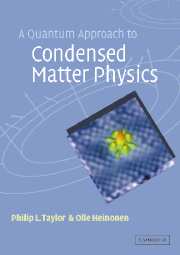Book contents
- Frontmatter
- Contents
- Preface
- Chapter 1 Semiclassical introduction
- Chapter 2 Second quantization and the electron gas
- Chapter 3 Boson systems
- Chapter 4 One-electron theory
- Chapter 5 Density functional theory
- Chapter 6 Electron–phonon interactions
- Chapter 7 Superconductivity
- Chapter 8 Semiclassical theory of conductivity in metals
- Chapter 9 Mesoscopic physics
- Chapter 10 The quantum Hall effect
- Chapter 11 The Kondo effect and heavy fermions
- Bibliography
- Index
Chapter 7 - Superconductivity
Published online by Cambridge University Press: 05 June 2012
- Frontmatter
- Contents
- Preface
- Chapter 1 Semiclassical introduction
- Chapter 2 Second quantization and the electron gas
- Chapter 3 Boson systems
- Chapter 4 One-electron theory
- Chapter 5 Density functional theory
- Chapter 6 Electron–phonon interactions
- Chapter 7 Superconductivity
- Chapter 8 Semiclassical theory of conductivity in metals
- Chapter 9 Mesoscopic physics
- Chapter 10 The quantum Hall effect
- Chapter 11 The Kondo effect and heavy fermions
- Bibliography
- Index
Summary
The superconducting state
The discovery, in Section 6.5, of an attractive interaction between electrons in a metal has mentally prepared us for the existence of a phase transition in the electron gas at low temperatures. It would, however, never have prepared us to expect a phenomenon as startling and varied as superconductivity if we were not already familiar with the experimental evidence. The ability to pass an electrical current without any measurable resistance has now been found in a wide range of types of material, including simple elements like mercury, metallic alloys, organic salts containing five- or six-membered rings of carbon and sulfur atoms, and ceramic oxides containing planes of copper and oxygen atoms.
In this chapter we shall concentrate mainly on the simplest type of superconductor, typified by elements such as tin, zinc, or aluminum. The organic superconductors and the ceramic oxides have properties that are so anisotropic that the theories developed to treat elemental materials are not applicable. Accordingly, with the exception of the final Section 7.11, the discussion that follows in this chapter applies only to the classic low-temperature superconductors.
Some of the properties of these materials are shown in Fig. 7.1.1, in which the resistivity, ρ, specific heat, C, and damping coefficient for phonons, α, are plotted as functions of temperature for a typical superconductor. At the transition temperature, Tc, a second-order phase transition occurs, the most spectacular consequence being the apparent total disappearance of resistance to weak steady electric currents.
- Type
- Chapter
- Information
- A Quantum Approach to Condensed Matter Physics , pp. 232 - 284Publisher: Cambridge University PressPrint publication year: 2002



